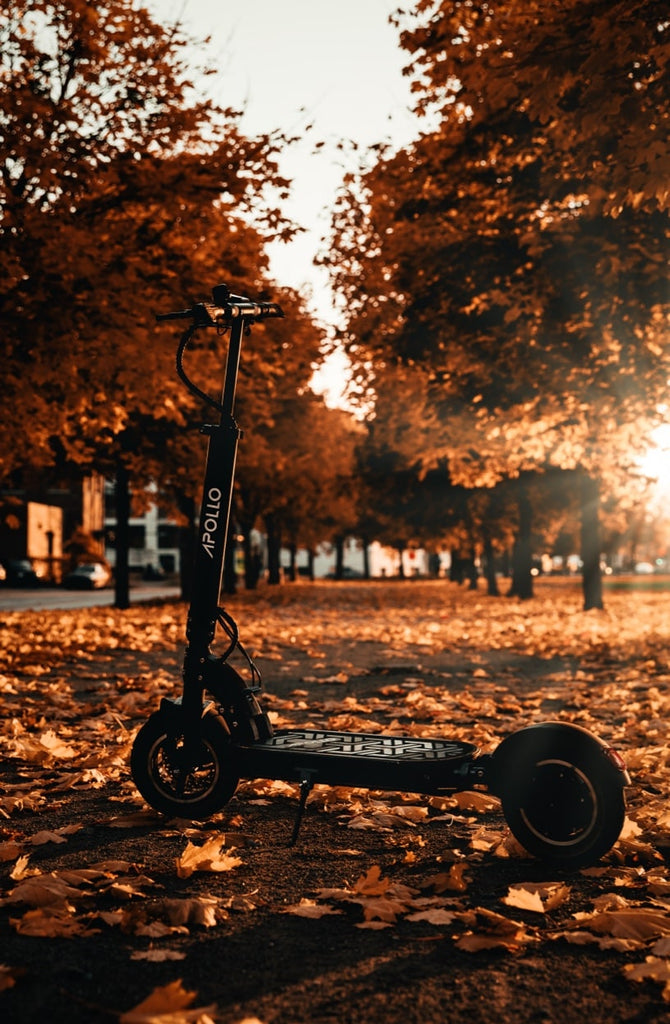Gliding down the city streets on an electric scooter can transform your daily commute into an exciting joyride. Compared to cars, e-scooters are much more cost-effective, convenient, and most importantly, fun!
But one question remains: Are they eco-friendly?
In the face of climate change, many consumers are increasingly concerned about their environmental impact, especially when it comes to transportation. After all, transportation makes up nearly 30% of the average American’s carbon footprint. (1)
We’re happy to report that swapping out your daily car commute with an electric scooter ride can make a significant difference in your total carbon emissions. Below, we’ll break down a few of the environmental benefits of electric scooters in detail.
Electric scooters and the environment
To be considered eco-friendly, a product needs to conserve energy, reduce carbon emissions, or prevent various forms of pollution. Purchasing such products is a way to vote with your dollar for a greener, cleaner world.

So, is an electric scooter eco-friendly?
The short answer is: Yes—but it depends. Some electric scooters are more eco-friendly than others. The following factors all play a role in the environmental impact of these vehicles:
- Whether they’re privately owned or rented from a shared e-scooter company
- How well they’re taken care of
- The types of transportation they replace (cars, buses, bicycles, walking, etc.)
- Whether or not they’re recycled at the end of their useful life
By choosing the right type of e-scooter and using it properly, you can optimize its eco-friendliness.
How Are Electric Scooters Good For the Environment?
Electric scooters have several environmental advantages over other types of vehicles.
Here are five of their eco-friendly features:
#1 Electric Scooter Rides Are Emission-Free
It’s no secret that gas-powered vehicles are a huge contributor to carbon emissions. The EPA discovered that the average passenger vehicle emits 4.6 metric tons of carbon dioxide each year.(2) For reference, that’s heavier than the weight of an elephant!(3)

In contrast, electric scooters produce zero carbon emissions while they're in use. That’s a huge improvement over their gas-guzzling counterparts. However, this emission reduction is only realized if you use your electric scooter in place of emission-producing vehicles. Riding a scooter instead of walking or biking won’t have any net benefit.
The National Association of City Transportation Officials (NACTO) found that 45% of e-scooter rides do replace car rides.(4) That means that e-scooters eliminated 39 million car trips in 2019 alone. That’s a lot of saved emissions!
By swapping out a few car trips a week with your electric scooter, you can make a notable dent in your carbon footprint.
But What About The Emissions Produced During The Manufacturing Process?
Like cars, electric scooters have to be manufactured. Unfortunately, the manufacturing process is not emission-free.

Compared to cars, e-scooters still come out on top by a long shot. After factoring in the emissions produced during manufacturing and maintenance, cars produce seven times more carbon dioxide over their lifespan.(5)
You can reduce your e-scooter carbon emissions by investing in a high-quality electric scooter and taking great care of it. Doing so will extend its lifespan and reduce its maintenance needs.
What About The Emissions From Charging?
Many environmentally-conscious people have pointed out that the charging process for electric scooters is often less green than you might think. Fortunately, you can take this process into your own hands.
Here are the factors that determine how environmentally friendly the charging process is:
-
How the scooter is transported to the charging location – Unfortunately, dockless shared electric scooters (such as the ones from Bird or Lime) undo a lot of their eco-friendly benefits with their energy-inefficient charging process.
Shared rental e-scooters usually get picked up by cars or trucks at night to get charged. After that, they’re redistributed throughout the city in the morning. Due to their reliance on gas-powered vehicles to get charged, they counteract some of the environmental benefits of using an electric scooter.
You can evade this environmental faux pas by investing in your own electric scooter and charging it more efficiently from your home.
-
How you manage your e-scooter’s battery – Electric scooter batteries require regular charging to stay on the go. When you own your e-scooter, you can use a more eco-friendly energy source to charge it, such as solar power.
You can also extend the battery life of your e-scooter by storing it in a dry, cool place. Doing so will protect its lithium battery from overheating. Heat is known to tank the longevity of lithium batteries.
Lastly, many electric scooter experts recommend riding your scooter when its battery is charged between 30% to 80% of its total capacity.(6) Operating it within this sweet spot has been shown to increase the battery’s lifespan by up to four times.
As you can see, the charging process can be made more eco-friendly by purchasing your own electric scooter and taking great care of its battery.
#2 Electric Scooters Require Fewer Raw Materials to Produce Than Cars
Electric scooters aren’t just lighter when it comes to their emissions—they’re also lighter physically. In turn, they use up fewer raw materials and are more energy-efficient to move.

Let’s take a deeper look at these eco-friendly factors:
-
Materials – The average car weighs between 2,000 to 4,000 pounds.(7) In contrast, electric scooters weigh a mere 15 to 150 pounds, depending on the model you choose. That’s a fraction of the weight of most standard passenger vehicles.
Due to their streamlined design, e-scooters require far fewer materials to produce. Subsequently, they have fewer parts that you’ll need to replace over their lifespan, especially if you choose a well-made model.
By using fewer materials, e-scooters have a notable environmental advantage over cars, trucks, buses, and mopeds.
-
Energy – Not only do electric scooters require fewer materials, but they’re also 1,000% more efficient per mile than cars.(8) This energy efficiency is due to the fact that they don’t have to support a large, bulky frame.
In contrast, cars have to use up a considerable amount of energy to support their weight and passengers while in motion.
Both of these factors are wins for electric scooters, as far as the planet is concerned.
#3 Electric Scooters Reduce Traffic Congestion, Air Pollution, and Noise Pollution
Electric scooters have been embraced in many big cities because they enhance urban mobility. However, they’re not just beneficial for their riders. They also benefit everyone else in the city, as well as the urban environment.

Here’s how:
-
Electric scooters don't emit any exhaust into the air – Did you know that carbon-emitting vehicles are one of the leading contributors to air pollution?(9) Their exhaust creates smoggy air that’s both unpleasant to look at and bad for your health. Poor air quality has been linked to a host of health issues, such as asthma, bronchitis, and cancer.(10)
By swapping out your car for an electric scooter, you can feel good about doing your part to reduce this harmful air pollution.
-
Electric scooters reduce noise pollution – In urban environments, noise pollution is more than just a nuisance. It can cause a slew of health problems for city-dwellers who are constantly subjected to it, such as hypertension, hearing loss, and poor sleep.(11)
Fortunately, electric scooters are very quiet. Using one in place of a car can reduce the noise pollution plaguing your city.
-
Electric scooters reduce overcrowding on the road – A whopping 76% of people conduct their daily car commute alone.(12) With so many cars on the road, traffic congestion can make moving through the city a lot more cumbersome. Additionally, finding parking can feel impossible—it's a scarce resource in busy cities.
The more people who can find alternative ways to travel from point A to point B, the better. By opting for an electric scooter, you can ride around solo guilt-free and avoid dealing with a parking headache at your final destination.
As you can see, reducing your contribution to your city’s pollution and traffic congestion is just one more way an electric scooter can help you embody a more eco-friendly lifestyle.
#4 Electric Scooters Are Less Damaging to the Environment When They’re Disposed
Throughout the lifespan of an electric scooter, they bring a lot of environmental perks to the table. But what about at the end of their life? After all, no vehicle lasts forever.
The eco-friendliness of this stage has a lot to do with whether your scooter is shared or privately owned:
-
Shared – Shared rental scooters tend to have significantly shorter lifespans. As a result, they’re disposed of at much higher rates. At best, the average shared electronic scooter only lasts a handful of months out on the streets. (13) These shared vehicles take a beating from the elements and their riders. You could say that they live fast and die young.
Their short lifespan is largely due to the fact that they’re:
- Stored outdoors for prolonged periods of time, rain or shine
- Exposed to dust, dirt, and other particles from the city
- Left out in the battery-damaging heat
- Haphazardly dropped on busy sidewalks and streets after being ridden
- Frequently used by careless or inexperienced riders who are more prone to accidents
With such frequent turnover, shared rental e-scooters are less eco-friendly than their privately-owned counterparts. Even if they’re recycled, they end up costing the planet with their frequent turnover.
Privately Owned – On the flip side, privately-owned electric scooters are easier on the environment, due to their longer lifespans. Unlike shared scooters that are commonly used by rookie riders, privately-owned scooters tend to be ridden by people who know what they’re doing.
-
After you invest your money in an electric scooter, you’ll be much more motivated to:
- Store it in a safe, dry place
- Clean it regularly
- Keep it inside, away from extreme temperatures
- Ride it carefully and more skillfully as you become more experienced
If you treat your electric scooter right, it will last you for years to come. Once your time with it is over, you can ask your manufacturer if they have a recycling program.
Compared to cars and other larger vehicles, both types of electric scooters are better for the environment. However, owning a scooter is undoubtedly better than renting one in this regard.
#5 Widespread Electric Scooter Adoption Can Inspire Positive Change
On an individual level, there’s only so much you can do to protect the environment. Oftentimes, lawmakers and local leaders need to get involved to enact more meaningful change.
As more people try out electronic scooters and discover their eco-friendly impact, cities may be more motivated to make policy changes that support their widespread adoption. For example, electric scooter enthusiasts can advocate for:
- Clearer laws regarding electric scooter riding on public roads
- Wider bike paths, scooter lanes, and sidewalks
- Better regulations for shared rental scooters
With so many people trying out this mode of transportation, there’s sure to be a handful of activists in the bunch ready to pave the way for positive change.
Optimize The Sustainability of Your Electric Scooter With Apollo
Electric scooters are undeniably better for the environment than cars and other passenger vehicles. To maximize the sustainability of your green ride, we recommend:
- Purchasing an e-scooter that’s of exceptional quality
- Storing it in a dry, temperature-controlled place
- Replacing as many car trips as you can with your new ride
- Advocating your better electric scooter laws and lanes in your city
- Disposing of your e-scooter responsibly at the end of its life
By taking these steps, you can contribute to a cleaner, greener world. If you get a few of your friends to join your fleet, these environmental benefits can be multiplied.

Now that you know the eco-friendly impact of electric scooters, it’s time to find a scooter that can support your green goals. Here at Apollo Scooters, we create top-of-the-line electric scooters that are built to last. Our vehicles are made primarily of aluminum, so they’re also super easy to recycle.
Find your eco-friendly, city-sprinting ride at Apollo today.
Sources:
(1) PBS. 5 Charts Show How Your Household Drives up Global Greenhouse Gas Emissions.
(2) EPA. Greenhouse Gas Emissions from a Typical Passenger Vehicle.
https://www.epa.gov/greenvehicles/greenhouse-gas-emissions-typical-passenger-vehicle
(3) Weight of Stuff. 11 Things That Weigh About 4 Tons.
https://weightofstuff.com/list-of-things-that-weight-4-tons/
(4) NACTO. Shared Micromobility in the U.S.: 2019.
https://nacto.org/shared-micromobility-2019/
(5) TNMT. The Environmental Impact of Today’s Transport Types.
https://tnmt.com/infographics/carbon-emissions-by-transport-type/
(6) Electric Scooter Reviews. How to Charge an Electric Scooter: According to Science.
https://electric-scooter.guide/guides/how-to-charge-electric-scooter/
(7) Autolist. How Much Does a Car Weigh?
https://www.autolist.com/guides/average-weight-of-car
(8) WIRED. Let's Count the Ways E-Scooters Could Save the City.
https://www.wired.com/story/e-scooter-micromobility-infographics-cost-emissions/
(9) WHO. Air Pollution.
https://www.who.int/health-topics/air-pollution
(10) Union of Concerned Scientists. Vehicles, Air Pollution, and Human Health.
https://www.ucsusa.org/resources/vehicles-air-pollution-human-health
(11) Environmental Pollution Centers. What is Noise Pollution?
https://www.environmentalpollutioncenters.org/noise-pollution
(12) The Washington Post. The Lonely American Commute.
https://www.washingtonpost.com/news/wonk/wp/2015/08/14/the-lonely-american-commute/
(13) Mashable. Shared Scooters Barely Last a Month, Report Says. But That Could Change.
https://mashable.com/article/escooter-lifespan-shared-new-models
















